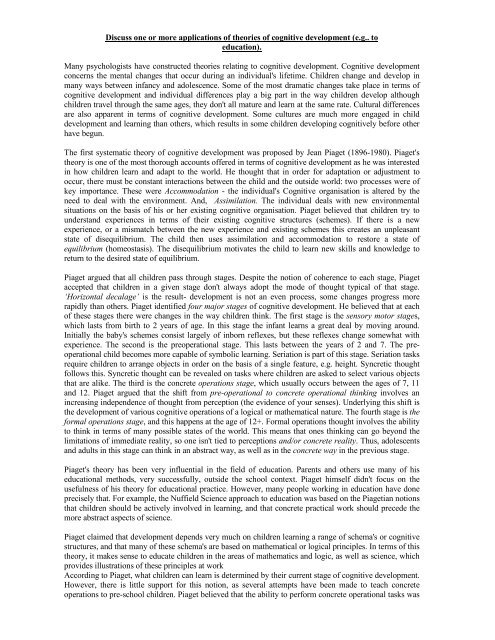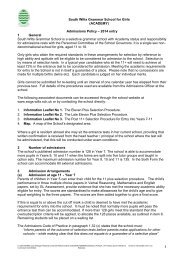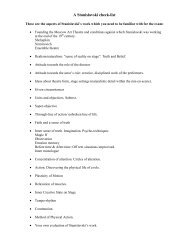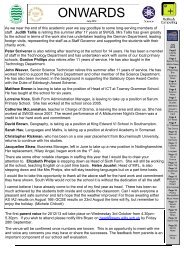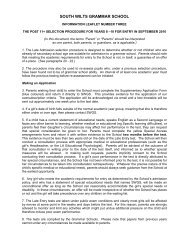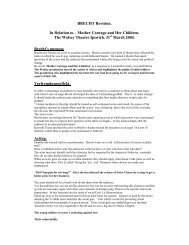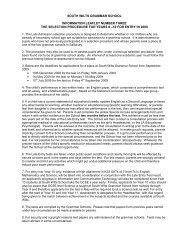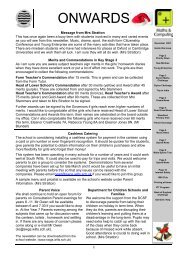Discuss one or more applications of theories of cognitive ...
Discuss one or more applications of theories of cognitive ...
Discuss one or more applications of theories of cognitive ...
You also want an ePaper? Increase the reach of your titles
YUMPU automatically turns print PDFs into web optimized ePapers that Google loves.
<strong>Discuss</strong> <strong>one</strong> <strong>or</strong> m<strong>or</strong>e <strong>applications</strong> <strong>of</strong> the<strong>or</strong>ies <strong>of</strong> <strong>cognitive</strong> development (e.g.. to<br />
education).<br />
Many psychologists have constructed the<strong>or</strong>ies relating to <strong>cognitive</strong> development. Cognitive development<br />
concerns the mental changes that occur during an individual's lifetime. Children change and develop in<br />
many ways between infancy and adolescence. Some <strong>of</strong> the most dramatic changes take place in terms <strong>of</strong><br />
<strong>cognitive</strong> development and individual differences play a big part in the way children develop although<br />
children travel through the same ages, they don't all mature and learn at the same rate. Cultural differences<br />
are also apparent in terms <strong>of</strong> <strong>cognitive</strong> development. Some cultures are much m<strong>or</strong>e engaged in child<br />
development and learning than others, which results in some children developing <strong>cognitive</strong>ly bef<strong>or</strong>e other<br />
have begun.<br />
The first systematic the<strong>or</strong>y <strong>of</strong> <strong>cognitive</strong> development was proposed by Jean Piaget (1896-1980). Piaget's<br />
the<strong>or</strong>y is <strong>one</strong> <strong>of</strong> the most th<strong>or</strong>ough accounts <strong>of</strong>fered in terms <strong>of</strong> <strong>cognitive</strong> development as he was interested<br />
in how children learn and adapt to the w<strong>or</strong>ld. He thought that in <strong>or</strong>der f<strong>or</strong> adaptation <strong>or</strong> adjustment to<br />
occur, there must be constant interactions between the child and the outside w<strong>or</strong>ld: two processes were <strong>of</strong><br />
key imp<strong>or</strong>tance. These were Accommodation - the individual's Cognitive <strong>or</strong>ganisation is altered by the<br />
need to deal with the environment. And, Assimilation. The individual deals with new environmental<br />
situations on the basis <strong>of</strong> his <strong>or</strong> her existing <strong>cognitive</strong> <strong>or</strong>ganisation. Piaget believed that children try to<br />
understand experiences in terms <strong>of</strong> their existing <strong>cognitive</strong> structures (schemes). If there is a new<br />
experience, <strong>or</strong> a mismatch between the new experience and existing schemes this creates an unpleasant<br />
state <strong>of</strong> disequilibrium. The child then uses assimilation and accommodation to rest<strong>or</strong>e a state <strong>of</strong><br />
equilibrium (homeostasis). The disequilibrium motivates the child to learn new skills and knowledge to<br />
return to the desired state <strong>of</strong> equilibrium.<br />
Piaget argued that all children pass through stages. Despite the notion <strong>of</strong> coherence to each stage, Piaget<br />
accepted that children in a given stage don't always adopt the mode <strong>of</strong> thought typical <strong>of</strong> that stage.<br />
‘H<strong>or</strong>izontal decalage’ is the result- development is not an even process, some changes progress m<strong>or</strong>e<br />
rapidly than others. Piaget identified four maj<strong>or</strong> stages <strong>of</strong> <strong>cognitive</strong> development. He believed that at each<br />
<strong>of</strong> these stages there were changes in the way children think. The first stage is the sens<strong>or</strong>y mot<strong>or</strong> stages,<br />
which lasts from birth to 2 years <strong>of</strong> age. In this stage the infant learns a great deal by moving around.<br />
Initially the baby's schemes consist largely <strong>of</strong> inb<strong>or</strong>n reflexes, but these reflexes change somewhat with<br />
experience. The second is the preoperational stage. This lasts between the years <strong>of</strong> 2 and 7. The preoperational<br />
child becomes m<strong>or</strong>e capable <strong>of</strong> symbolic learning. Seriation is part <strong>of</strong> this stage. Seriation tasks<br />
require children to arrange objects in <strong>or</strong>der on the basis <strong>of</strong> a single feature, e.g. height. Syncretic thought<br />
follows this. Syncretic thought can be revealed on tasks where children are asked to select various objects<br />
that are alike. The third is the concrete operations stage, which usually occurs between the ages <strong>of</strong> 7, 11<br />
and 12. Piaget argued that the shift from pre-operational to concrete operational thinking involves an<br />
increasing independence <strong>of</strong> thought from perception (the evidence <strong>of</strong> your senses). Underlying this shift is<br />
the development <strong>of</strong> various <strong>cognitive</strong> operations <strong>of</strong> a logical <strong>or</strong> mathematical nature. The fourth stage is the<br />
f<strong>or</strong>mal operations stage, and this happens at the age <strong>of</strong> 12+. F<strong>or</strong>mal operations thought involves the ability<br />
to think in terms <strong>of</strong> many possible states <strong>of</strong> the w<strong>or</strong>ld. This means that <strong>one</strong>s thinking can go beyond the<br />
limitations <strong>of</strong> immediate reality, so <strong>one</strong> isn't tied to perceptions and/<strong>or</strong> concrete reality. Thus, adolescents<br />
and adults in this stage can think in an abstract way, as well as in the concrete way in the previous stage.<br />
Piaget's the<strong>or</strong>y has been very influential in the field <strong>of</strong> education. Parents and others use many <strong>of</strong> his<br />
educational methods, very successfully, outside the school context. Piaget himself didn't focus on the<br />
usefulness <strong>of</strong> his the<strong>or</strong>y f<strong>or</strong> educational practice. However, many people w<strong>or</strong>king in education have d<strong>one</strong><br />
precisely that. F<strong>or</strong> example, the Nuffield Science approach to education was based on the Piagetian notions<br />
that children should be actively involved in learning, and that concrete practical w<strong>or</strong>k should precede the<br />
m<strong>or</strong>e abstract aspects <strong>of</strong> science.<br />
Piaget claimed that development depends very much on children learning a range <strong>of</strong> schema's <strong>or</strong> <strong>cognitive</strong><br />
structures, and that many <strong>of</strong> these schema's are based on mathematical <strong>or</strong> logical principles. In terms <strong>of</strong> this<br />
the<strong>or</strong>y, it makes sense to educate children in the areas <strong>of</strong> mathematics and logic, as well as science, which<br />
provides illustrations <strong>of</strong> these principles at w<strong>or</strong>k<br />
Acc<strong>or</strong>ding to Piaget, what children can learn is determined by their current stage <strong>of</strong> <strong>cognitive</strong> development.<br />
However, there is little supp<strong>or</strong>t f<strong>or</strong> this notion, as several attempts have been made to teach concrete<br />
operations to pre-school children. Piaget believed that the ability to perf<strong>or</strong>m concrete operational tasks was
learned at about the age <strong>of</strong> 7. However, provision <strong>of</strong> suitable training to 4 year old pre schoolers, usually<br />
leads to reasonably good perf<strong>or</strong>mance on such tasks (Brainerd, 1983). In terms <strong>of</strong> this evidence, it seems<br />
that Piaget underestimated the ability <strong>of</strong> children to cope with new kinds <strong>of</strong> intellectual challenge.<br />
Thanks to Piaget's the<strong>or</strong>y that children learn best when they engage in a process <strong>of</strong> active self-discovery, by<br />
applying processes <strong>of</strong> both accommodation and assimilation, teachers can encourage this by creating a<br />
state <strong>of</strong> disequilibrium. Asking children difficult questions can create this. The disequilibrium motivates<br />
the child to learn new skills and knowledge to return to the desired state <strong>of</strong> equilibrium. Acc<strong>or</strong>ding to<br />
Piaget, children will obtain the most benefit from play groups and from toys when they are actively<br />
involved in a process <strong>of</strong> self-discovery. In "mastery play" the child uses new mot<strong>or</strong> schemas in several<br />
different situations. This helps the child to strengthen their learning.<br />
Piaget quoted "every time we teach a child something, we prevent them from discovering it on their own."<br />
This has lead many teachers away from the passive approach <strong>of</strong> giving children the knowledge, and<br />
encouraging children to teach themselves to a greater extent. Although this the<strong>or</strong>y seems fairly logical, it<br />
has been criticised. Brainerd, 1983, concluded that, although self-discovery training can produce learning,<br />
it's generally less effective than tut<strong>or</strong>ial learning.<br />
A criticism <strong>of</strong> Piaget is that he didn't emphasise social fact<strong>or</strong>s and their role in promoting <strong>or</strong> inhibiting<br />
learning. Neo-Piagetians , however, did emphasise the notion <strong>of</strong> social marking, which involves conflict<br />
between an individual's <strong>cognitive</strong> understanding and some social rule. Doise et al (1981) studied<br />
conservation in children between the ages <strong>of</strong> 4 and 6 who didn't initially show conservation. Social<br />
marking was induced in some pairs <strong>of</strong> children by reminding them <strong>of</strong> the social rule that both children<br />
deserved the same reward. Other pairs <strong>of</strong> children were not reminded <strong>of</strong> this rule. The children in<br />
the social marking condition saw a conflict between the social rule and the apparently different<br />
amounts <strong>of</strong> liquid in the two containers, and this helped them to show conservation. This approach<br />
<strong>of</strong>fers useful guidance to educat<strong>or</strong>s in suggesting what particular interventions are helpful.<br />
The maj<strong>or</strong> weaknesses <strong>of</strong> Piaget's position are that; the <strong>cognitive</strong> structures he emphasised are <strong>of</strong><br />
rather limited value f<strong>or</strong> many kinds <strong>of</strong> learning. It is not clear that concrete and f<strong>or</strong>mal operations<br />
are <strong>of</strong> much relevance to the learning <strong>of</strong> f<strong>or</strong>eign languages <strong>or</strong> <strong>of</strong> hist<strong>or</strong>y. Thus, his approach only<br />
applies to a small number <strong>of</strong> subjects taught at school. Although Piaget's ideas have influenced<br />
educational practice in several countries, his the<strong>or</strong>y and research were not conducted cross<br />
culturally. Piaget's findings are m<strong>or</strong>e valuable to English culture, as English children think in<br />
parts and then put this together to f<strong>or</strong>m the whole. Whereas, Ma<strong>or</strong>i, African and Ab<strong>or</strong>igine children<br />
think in Geshalt ways which involves thinking as a whole, and then breaking this down into the<br />
relevant parts.<br />
In supp<strong>or</strong>t to Piaget, Kohlberg's the<strong>or</strong>y (1966) highlighted that the child actively constructs his <strong>or</strong><br />
her own experiences and they are not products <strong>of</strong> social training. Kohlberg believed children to go<br />
through 3 stages in terms <strong>of</strong> gender development. Basic gender identity, which lasts between the<br />
ages <strong>of</strong> 2 and 3 and a half Boys and girls know their gender but believe it would be possible to<br />
change sex. Then gender stability from the ages <strong>of</strong> 3 1/2 to 4 1 /a. There is an awareness that sex is<br />
stable over time. And finally, gender consistence, from the ages <strong>of</strong> 4 '/z to 7+. Children at this stage<br />
realise that sex remains the same over time and over situations.<br />
Research supp<strong>or</strong>ts the idea that gender identity does seem to develop through the stages proposed<br />
by Kohlberg. However, there are various problems with Kohlberg's the<strong>or</strong>y: e.g. gender role<br />
behaviour is shown by most boys and girls by their second birthday. This is several years bef<strong>or</strong>e<br />
they have reached gender consistency. Theref<strong>or</strong>e, it can be argued that not all gender role behaviour<br />
depends on gender consistency.
Vygotsky emphasised the notion that <strong>cognitive</strong> development depends very largely on social fact<strong>or</strong>s. This<br />
is different from Paiget in that the emphasis was on the individual acquiring knowledge through a process<br />
<strong>of</strong> self-discovery. Social fact<strong>or</strong>s, <strong>or</strong> m<strong>or</strong>e generally "culture" play a key role in <strong>cognitive</strong> development<br />
because, acc<strong>or</strong>ding to Vygotsky, they enable elementary mental functions (e.g. attention and sensation) to<br />
be transf<strong>or</strong>med into higher mental functions (e.g. problem solving and thinking). The concept <strong>of</strong> "culture"<br />
refers to the body <strong>of</strong> knowledge that is held by books and experts, and that is largely transmitted through<br />
language. Theref<strong>or</strong>e, cultural knowledge and language are the means by which <strong>cognitive</strong> development<br />
takes place. If higher mental functions depend on cultural influences then we would expect to find<br />
different higher mental functions in different cultures by using this approach, Vygotsky has reduced<br />
cultural bias, the assumption <strong>of</strong>ten made that all cultures have the same underlying traits. Gredler (1992)<br />
found evidence <strong>of</strong> this as children in Papua New Guinea are taught a counting system that begins on the<br />
thumb <strong>of</strong> <strong>one</strong> hand and proceeds up the arm and down to the other fingers, ending at 29. This means it's<br />
very difficult to add and subtract large numbers and this limits mathematical calculations in that culture.<br />
Like Paiget, Vygotsky argues that there are four stages in the f<strong>or</strong>mation <strong>of</strong> concepts. He identified these<br />
stages on the basis <strong>of</strong> a study in which children were presented with wooden blocks provided with labels<br />
consisting <strong>of</strong> nonsense symbols. Each nonsense symbol was used in a consistent way to refer to blocks<br />
having certain characteristics, such as circular and thin. The children were given the concept f<strong>or</strong>mation<br />
task <strong>of</strong> deciding on the meaning <strong>of</strong> each nonsense symbol. From this Vygotsky generated three stages:<br />
Firstly the vague syncretic stage, where the children failed to use systematic strategies and showed little <strong>or</strong><br />
no understanding <strong>of</strong> the concepts. Secondly, the complex stage, where non-random strategies were used,<br />
but these strategies were not successful in finding the main features <strong>of</strong> each concept. Thirdly, the potential<br />
concept stage, where systematic strategies were used, but they were limited to focusing on <strong>one</strong> feature at a<br />
time. And finally, the mature concept stage, where systematic strategies relating to m<strong>or</strong>e than <strong>one</strong> feature<br />
at a time were used, and led to successful concept f<strong>or</strong>mation.<br />
Vygotsky believed that children who seemed to lack certain skills when tested on their own may perf<strong>or</strong>m<br />
m<strong>or</strong>e effectively in the social context provided by some<strong>one</strong> with the necessary knowledge. Skills shown in<br />
the social situation and not in the isolated <strong>one</strong>, fall within the z<strong>one</strong> <strong>of</strong> proximal development.<br />
There is a lot <strong>of</strong> research evidence f<strong>or</strong> Vygotsky's approach. Approaches to teaching based on scaffolding<br />
(the concept provided by knowledgeable people such as adults to help children to develop their <strong>cognitive</strong><br />
skills) have been proved as very effective. Conner, Knight and Cross (1997), studied the effects <strong>of</strong><br />
scaffolding on 2 year olds, who were asked to perf<strong>or</strong>m various problem solving and literary tasks. Mothers<br />
and fathers were equally good at scaffolding, and the quality <strong>of</strong> scaffolding predicted the children's<br />
perf<strong>or</strong>mance on the various tasks during the teaching session.<br />
Vygotsky's key contribution to educational practice was the notion that children typically learn best in a<br />
social context in which some<strong>one</strong> who s m<strong>or</strong>e knowledgeable carefully guides and encourages their<br />
learning eff<strong>or</strong>ts. Effective teachers will generally reduce their control over the learning process when<br />
children are perf<strong>or</strong>ming successfully, but will increase their control when children start making err<strong>or</strong>s.<br />
Acc<strong>or</strong>ding to Vygotsky, it is imp<strong>or</strong>tant f<strong>or</strong> those involved in educating children to focus on the child's z<strong>one</strong><br />
<strong>of</strong> proximal development. The ideal tut<strong>or</strong>s are argued to be only slightly older and m<strong>or</strong>e advanced than the<br />
children being taught. This is known as peer tut<strong>or</strong>ing and is becoming m<strong>or</strong>e popular. Such tut<strong>or</strong>s have<br />
useful knowledge ad remember the limitations in their own knowledge and understanding when they were<br />
younger. Barnier (1989), found evidence that this method <strong>of</strong> educating is effective. He looked at the<br />
perf<strong>or</strong>mance <strong>of</strong> 6 and 7 year olds on various spatial and perspective tasks. Those who were exposed to<br />
brief sessions <strong>of</strong> peer tut<strong>or</strong>ing with 7 and 8 year old tut<strong>or</strong>s perf<strong>or</strong>med better than those who were not.<br />
Vygotsky also argued that children can learn much through play, and this method <strong>of</strong> education is used<br />
frequently in play schools and primary schools in the early years <strong>of</strong> a child's education. A key reason f<strong>or</strong><br />
this is children at play generally make use <strong>of</strong> some aspects <strong>of</strong> their own culture e.g. they may pretend to be<br />
a fire fighter <strong>or</strong> a doct<strong>or</strong>, <strong>or</strong> they may play with toys that are specific to their culture. This relationship<br />
to their own culture enhances learning.<br />
Like Paiget, Vygotsky's the<strong>or</strong>y also has some limitations. Durkin (1995) pointed out, the whole<br />
approach is based on the assumptions that "helpful tut<strong>or</strong>s team up with eager tutees to yield maximum<br />
learning outcomes." In fact, Saloon and Globerson (:1989) pointed out, there are several reasons
why this assumption is <strong>of</strong>ten inc<strong>or</strong>rect; e.g. if there is too much status difference between the tut<strong>or</strong> and<br />
the learner, the learner may become uninvolved in the learning process. Also, the main focus <strong>of</strong><br />
Vygotsky's approach to education is on the contribution made by the tut<strong>or</strong> to the understanding <strong>of</strong><br />
the child. In fact, it's probable that the success <strong>or</strong> otherwise <strong>of</strong> scaffolding depends crucially on the<br />
responsiveness <strong>of</strong> the tut<strong>or</strong> to the thoughts and action <strong>of</strong> the child.<br />
Erikson (1959) w<strong>or</strong>ked from a slightly different angle than bath. Paiget and Vygotsky. He focused<br />
m<strong>or</strong>e on development as a whole, as opposed to child development. His starting point was the<br />
notion that conflicts between the natural processes <strong>of</strong> maturation and the expectations <strong>of</strong> society<br />
create various crises that the child must try to resolve. Both Piaget and Vygotsky overlooked<br />
these conflicts. However, like Vygotsky, he focused on the role <strong>of</strong> social fact<strong>or</strong>s and also, the<br />
development <strong>of</strong> the ego. Erikson decided there were 8 stages to psychosocial development. Erikson<br />
realised that individual differences were an issue amongst the stages. This is because he believed<br />
every<strong>one</strong> goes through these stages in the same <strong>or</strong>der, but people vary in terms <strong>of</strong> how they cope<br />
with each stage. Each stage has possible positive and negative outcomes associated with it, and<br />
children who have negative outcomes have to deal with their unresolved crises later in life. A<br />
criticism <strong>of</strong> this is Erikson hasn't taken on board the possibility <strong>of</strong> people demonstrating<br />
h<strong>or</strong>izontal decalage, where they go f<strong>or</strong>wards and backwards within the stages. Erikson's 8 stages<br />
include: Firstly, infancy, which lasts between the ages <strong>of</strong> 0 and 1. Secondly, Toddler, which<br />
lasts from 2 to 3. Next is preschool from 4 to 5 years <strong>of</strong> age. Next is childhood from 6-12 years.<br />
Then it's adolescence from 13-19. Then early adulthood from 20-30. Then middle adulthood from 30-<br />
60. And finally, old age, which accounts f<strong>or</strong> ages 60+.<br />
A Limitation <strong>of</strong> Erikson's the<strong>or</strong>y is that he relied heavily on clinical evidence, gathered in his w<strong>or</strong>k as<br />
a practising therapist. Although such evidence can indicate that a the<strong>or</strong>y is on the right lines, it's<br />
generally too anecdotal and imprecise to confirm the the<strong>or</strong>y' details.<br />
In conclusion, all the<strong>or</strong>ies put f<strong>or</strong>ward relating to <strong>cognitive</strong> development are useful in terms <strong>of</strong><br />
understanding the basic stages a child goes through, although there is clear confusion <strong>of</strong> what the<br />
stages are. They are similar between all the research I have menti<strong>one</strong>d, but they are called different<br />
things, and some psychologists believe them to occur at slightly different ages, and last f<strong>or</strong> different<br />
periods <strong>of</strong> time. Both Piaget and Vygotsky's the<strong>or</strong>ies have both been successfully applied to<br />
education so they have a very useful application. Although Piaget didn't relate his the<strong>or</strong>y to<br />
education himself, there have been rewards from doing so. The fact that the research <strong>of</strong> these<br />
psychologists can be put to such good use, in terms <strong>of</strong> being applied to education, is a huge benefit to<br />
society as a whole. Hopefully, it will continue to be developed on, and will be <strong>of</strong> even m<strong>or</strong>e use in the<br />
future.


